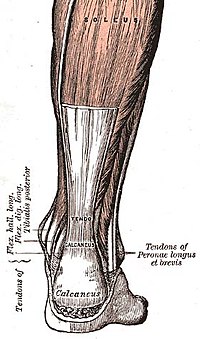
Photo from wikipedia
Patellar tendon rupture is an uncommon but disabling lesion. It usually occurs in men younger than 40 years, through direct or indirect trauma. Obtaining satisfactory results with treatment of chronic… Click to show full abstract
Patellar tendon rupture is an uncommon but disabling lesion. It usually occurs in men younger than 40 years, through direct or indirect trauma. Obtaining satisfactory results with treatment of chronic injuries and re-ruptures in which the patella retracts owing to quadriceps contraction is a challenge. This is of major concern especially in cases in which the patella cannot be positioned in its anatomic position when distal traction is performed. In these cases, V-Y stretching of the quadriceps can be performed in an attempt to perform reconstruction in 1 stage. Instead, a 2-stage procedure can be chosen, in which the first stage relies on patellar trans-skeletal traction to achieve distalization of the patella. In 1981, a technique for the treatment of chronic injuries of the patellar tendon in 2 stages was described. In that procedure, the first stage consisted of transpatellar traction and the second stage was tendon-tendon suturing with fascia lata reinforcement. We describe a surgical technique performed in 2 stages; in the first stage, trans-skeletal traction is performed, and in the second stage, the technique of Kelikian et al. with our modification is performed. This technique is used in patients with chronic rupture of the patellar tendon associated with a high patella with nonreducible quadriceps shortening.
Journal Title: Arthroscopy Techniques
Year Published: 2020
Link to full text (if available)
Share on Social Media: Sign Up to like & get
recommendations!